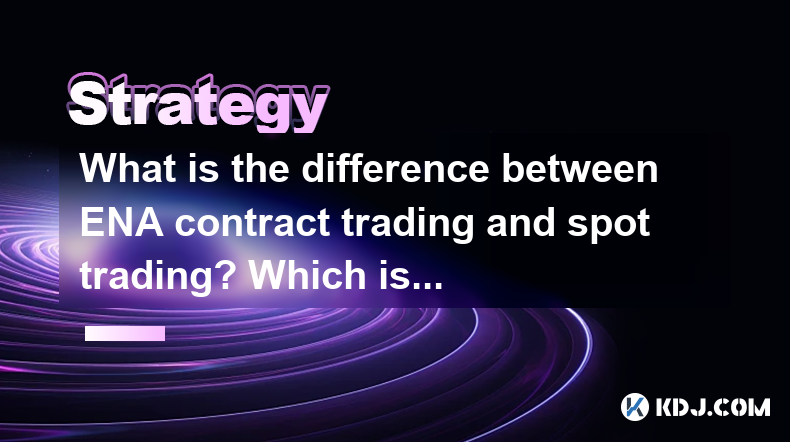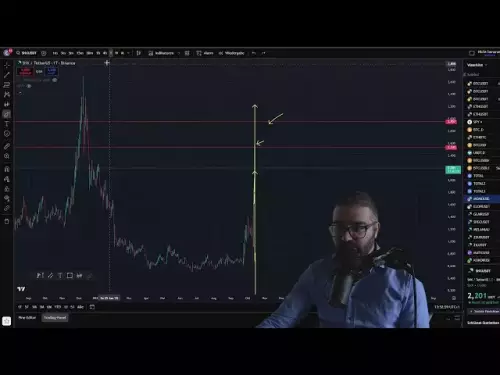-
 bitcoin
bitcoin $115692.075601 USD
5.13% -
 ethereum
ethereum $4162.931611 USD
11.68% -
 bnb
bnb $1310.063287 USD
17.56% -
 tether
tether $1.000983 USD
0.00% -
 xrp
xrp $2.534505 USD
8.16% -
 solana
solana $198.235737 USD
13.49% -
 usd-coin
usd-coin $1.000236 USD
0.02% -
 dogecoin
dogecoin $0.207352 USD
12.89% -
 tron
tron $0.323043 USD
3.62% -
 cardano
cardano $0.701559 USD
11.88% -
 hyperliquid
hyperliquid $39.924597 USD
8.30% -
 chainlink
chainlink $18.934457 USD
11.56% -
 ethena-usde
ethena-usde $1.000552 USD
0.02% -
 stellar
stellar $0.340575 USD
7.05% -
 bitcoin-cash
bitcoin-cash $545.011757 USD
8.86%
What is the difference between ENA contract trading and spot trading? Which is more suitable for ordinary investors?
ENA contract trading uses leverage and allows short positions, making it riskier but suitable for experienced traders; spot trading is simpler and less risky, ideal for ordinary investors.
May 07, 2025 at 04:01 am

When it comes to trading in the cryptocurrency market, understanding the differences between various trading methods is crucial for making informed decisions. In this article, we will delve into the specifics of ENA contract trading and spot trading, exploring their key differences and determining which might be more suitable for ordinary investors.
Understanding ENA Contract Trading
ENA contract trading involves trading contracts that derive their value from an underlying cryptocurrency. These contracts allow traders to speculate on the future price movements of a cryptocurrency without actually owning it. ENA contract trading is typically conducted through perpetual contracts, which do not have an expiration date and can be held indefinitely.
In ENA contract trading, traders can take both long and short positions. A long position means the trader expects the price of the cryptocurrency to rise, while a short position indicates an expectation that the price will fall. This flexibility allows traders to profit from both rising and falling markets.
ENA contract trading often involves the use of leverage, which means traders can borrow funds to increase their exposure to the market. While this can amplify potential profits, it also increases the risk of significant losses. Therefore, ENA contract trading is generally considered more suitable for experienced traders who are comfortable with higher risk.
Understanding Spot Trading
Spot trading, on the other hand, involves the direct buying and selling of cryptocurrencies at the current market price. When you engage in spot trading, you actually own the cryptocurrency you purchase, and you can hold it in your wallet or trade it at any time.
Spot trading is straightforward and does not involve leverage, making it less risky compared to contract trading. The primary goal of spot trading is to buy a cryptocurrency at a lower price and sell it at a higher price, thus profiting from the price difference.
Unlike ENA contract trading, spot trading does not allow you to take short positions directly. If you believe the price of a cryptocurrency will fall, you would need to sell your holdings and potentially buy back at a lower price later. This process is known as selling high and buying low.
Key Differences Between ENA Contract Trading and Spot Trading
The first major difference between ENA contract trading and spot trading lies in the ownership of the underlying asset. In spot trading, you own the cryptocurrency you buy, whereas in ENA contract trading, you are trading a contract that derives its value from the cryptocurrency.
The second major difference is the use of leverage. ENA contract trading often involves trading with leverage, which can significantly increase both potential profits and potential losses. Spot trading, on the other hand, does not typically involve leverage, making it less risky.
The third major difference is the ability to take short positions. ENA contract trading allows traders to take both long and short positions, enabling them to profit from falling markets as well as rising ones. Spot trading does not offer this flexibility directly, as you can only profit from price increases.
The fourth major difference is the complexity and risk level. ENA contract trading is generally more complex and carries higher risk due to the use of leverage and the ability to take short positions. Spot trading is simpler and less risky, making it more suitable for beginners.
Which is More Suitable for Ordinary Investors?
For ordinary investors, the choice between ENA contract trading and spot trading largely depends on their risk tolerance, trading experience, and investment goals.
Spot trading is generally more suitable for ordinary investors due to its simplicity and lower risk. Since spot trading does not involve leverage, the potential for significant losses is reduced. Additionally, spot trading allows investors to actually own the cryptocurrencies they purchase, which can be appealing for those who believe in the long-term potential of certain digital assets.
On the other hand, ENA contract trading may be more suitable for experienced investors who are comfortable with higher risk and are looking to profit from short-term market movements. The ability to use leverage and take short positions can be advantageous for those who have a deep understanding of the market and are willing to accept the associated risks.
Practical Considerations for Ordinary Investors
When deciding between ENA contract trading and spot trading, ordinary investors should consider several practical factors.
- Risk Management: Spot trading offers a more straightforward approach to risk management, as it does not involve leverage. For investors who prioritize capital preservation, spot trading may be the better choice.
- Investment Horizon: If you are looking to invest in cryptocurrencies for the long term, spot trading allows you to hold onto your assets and benefit from potential price appreciation over time. ENA contract trading is better suited for short-term trading strategies.
- Market Knowledge: ENA contract trading requires a higher level of market knowledge and understanding of technical analysis. Ordinary investors who are new to the cryptocurrency market may find spot trading more accessible and less daunting.
- Trading Platform: The choice of trading platform can also influence your decision. Some platforms may offer more features for ENA contract trading, while others may be better suited for spot trading. It's important to choose a platform that aligns with your trading preferences and offers the necessary tools and resources.
Frequently Asked Questions
Q: Can I switch between ENA contract trading and spot trading on the same platform?A: Yes, many cryptocurrency trading platforms offer both ENA contract trading and spot trading options. You can switch between the two types of trading depending on your strategy and market conditions. However, it's important to understand the specific rules and fees associated with each type of trading on your chosen platform.
Q: How do fees compare between ENA contract trading and spot trading?A: Fees can vary significantly between ENA contract trading and spot trading. ENA contract trading often involves higher fees due to the complexity of the contracts and the use of leverage. Spot trading typically has lower fees, as it involves straightforward buying and selling of cryptocurrencies. It's important to review the fee structures of your chosen trading platform before deciding which type of trading to pursue.
Q: Are there any regulatory differences between ENA contract trading and spot trading?A: Regulatory environments can differ between ENA contract trading and spot trading. In some jurisdictions, ENA contract trading may be subject to stricter regulations due to the use of leverage and the potential for significant losses. Spot trading, being more straightforward, may face fewer regulatory hurdles. It's crucial for investors to be aware of the regulatory landscape in their region and how it may impact their trading activities.
Q: Can I use the same wallet for ENA contract trading and spot trading?A: Typically, ENA contract trading and spot trading require different types of wallets. ENA contract trading is usually conducted on a trading platform's internal system, and you do not actually hold the cryptocurrency in a personal wallet. Spot trading, on the other hand, allows you to transfer your purchased cryptocurrencies to your personal wallet. Therefore, you would need to use a different wallet for each type of trading.
Disclaimer:info@kdj.com
The information provided is not trading advice. kdj.com does not assume any responsibility for any investments made based on the information provided in this article. Cryptocurrencies are highly volatile and it is highly recommended that you invest with caution after thorough research!
If you believe that the content used on this website infringes your copyright, please contact us immediately (info@kdj.com) and we will delete it promptly.
- XRP Price Prediction: Weekend Rollercoaster or Rally?
- 2025-10-12 08:45:16
- Bittensor (TAO): Super Bullish Signals Point to Potential 2x Rally
- 2025-10-11 10:25:12
- Silver Price Correction: Navigating the Dip & Identifying Key SEO Keywords
- 2025-10-11 10:25:12
- Decoding Crypto Trends: Bittensor's Bull Run, Cardano's Dip, and LivLive's Presale Buzz in 'Uptober 2025'
- 2025-10-12 08:45:16
- MoonBull: The Crypto Meme Coin Promising 1000x Gains?
- 2025-10-11 10:30:01
- Crypto Payroll Revolution: Stablecoins, Altcoins, and the Future of Salary Payments
- 2025-10-11 10:30:01
Related knowledge

Practical parameter settings for a Bitcoin multi-timeframe moving average system
Sep 18,2025 at 10:54pm
Optimizing Timeframe Combinations for Bitcoin Trading1. Selecting appropriate timeframes is crucial when building a multi-timeframe moving average sys...

How can I filter out false breakouts in Dogecoin high-frequency trading?
Sep 22,2025 at 01:00am
Understanding False Breakouts in Dogecoin Trading1. A false breakout occurs when Dogecoin's price appears to move beyond a defined support or resistan...

Techniques for identifying tops and bottoms in the Bitcoin on-chain NVT model
Sep 20,2025 at 07:54pm
Understanding the NVT Model in Bitcoin Analysis1. The Network Value to Transactions (NVT) ratio is often described as the 'P/E ratio' of the cryptocur...

What does the surge in open interest in Bitcoincoin futures mean?
Sep 20,2025 at 11:18pm
Understanding the Surge in Dogecoin Futures Open Interest1. A surge in open interest within Dogecoin futures indicates a growing number of active cont...

How can I use the Ethereum USDT premium to gauge market sentiment?
Sep 18,2025 at 11:55pm
Understanding the Ethereum USDT Premium1. The Ethereum USDT premium refers to the price difference between USDT (Tether) traded on Ethereum-based plat...

What should I do if Ethereum staking yields decline?
Sep 20,2025 at 06:18am
Understanding the Causes Behind Declining Ethereum Staking Yields1. The Ethereum network transitioned to a proof-of-stake consensus mechanism with the...

Practical parameter settings for a Bitcoin multi-timeframe moving average system
Sep 18,2025 at 10:54pm
Optimizing Timeframe Combinations for Bitcoin Trading1. Selecting appropriate timeframes is crucial when building a multi-timeframe moving average sys...

How can I filter out false breakouts in Dogecoin high-frequency trading?
Sep 22,2025 at 01:00am
Understanding False Breakouts in Dogecoin Trading1. A false breakout occurs when Dogecoin's price appears to move beyond a defined support or resistan...

Techniques for identifying tops and bottoms in the Bitcoin on-chain NVT model
Sep 20,2025 at 07:54pm
Understanding the NVT Model in Bitcoin Analysis1. The Network Value to Transactions (NVT) ratio is often described as the 'P/E ratio' of the cryptocur...

What does the surge in open interest in Bitcoincoin futures mean?
Sep 20,2025 at 11:18pm
Understanding the Surge in Dogecoin Futures Open Interest1. A surge in open interest within Dogecoin futures indicates a growing number of active cont...

How can I use the Ethereum USDT premium to gauge market sentiment?
Sep 18,2025 at 11:55pm
Understanding the Ethereum USDT Premium1. The Ethereum USDT premium refers to the price difference between USDT (Tether) traded on Ethereum-based plat...

What should I do if Ethereum staking yields decline?
Sep 20,2025 at 06:18am
Understanding the Causes Behind Declining Ethereum Staking Yields1. The Ethereum network transitioned to a proof-of-stake consensus mechanism with the...
See all articles










































































